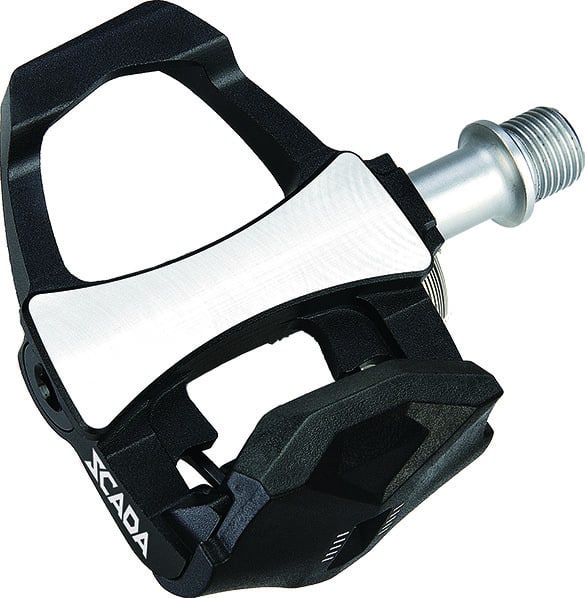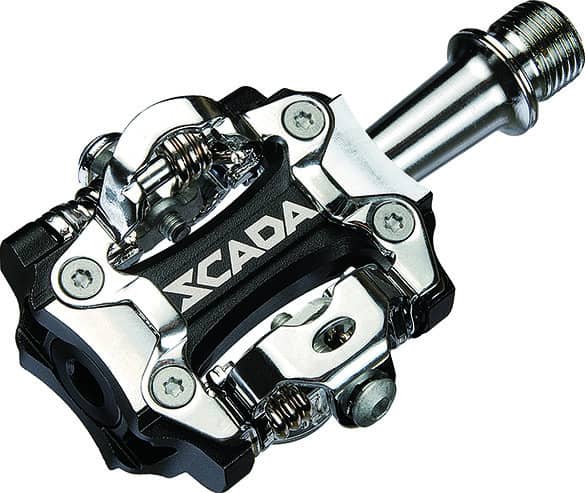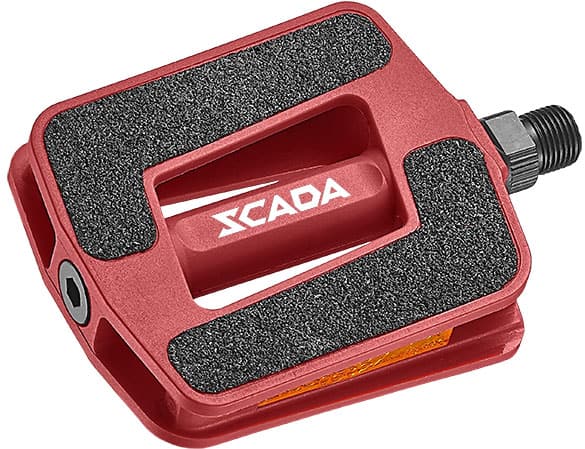BIKE PEDALS
The Ultimate Guide to Bike Pedals
Welcome to the most complete, comprehensive and awesome guide to Bike Pedals … ever!
Got a big brand? Or a smaller, exclusive brand?
Then you’ll find
- useful
- interesting, and
- totally relevant
info for your business. (You might like to also share it with your customers as an helpful FYI resource.)
If you’re a buyer researching your next product, skim through this article. You will be on the right track in no time, with a clearer idea of what you need.
What are the Different Types of Bike Pedals?
You can divide bike pedals into two groups: by function or by discipline/lifestyle.
By function we mean clip-in (also known as “clip-less”…we’ll explain that bit of weirdness soon) or flat (platform)
By discipline (or lifestyle which sounds way less serious 😄) we mean
- Road
- MTB
- BMX
- City Bike
- Indoor Cycling (or Spinning to many)
- Trekking
We’ll dive deeply into bike pedals from the lifestyle standpoint in most of this article.
But first, let’s sort out the confusing issue of clipless pedals vs the alternatives.
Clipless Pedals
The thing to remember is that “clip-less” actually means “clip-in”.
Why not just use “clip-in” then, for heaven’s sake?
Well, it’s the preferred term within the cycling community so we’ll stick with that. Besides, there is a logic to it . . .
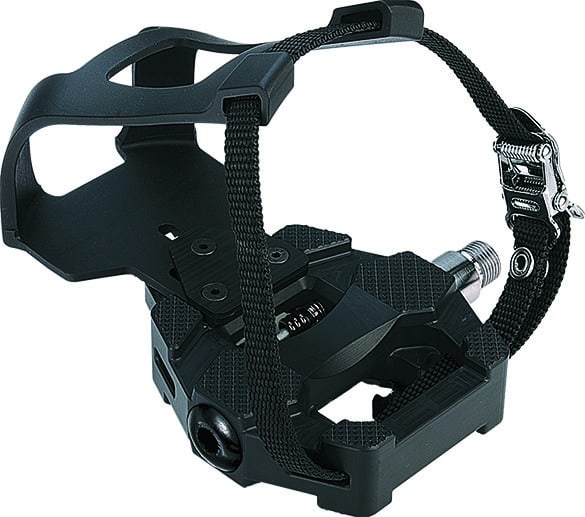
Clipless must be understood in contrast to the technology that came before it.
Toe “clips” (you didn’t actually clip in) were the improvement to and upgrade from flat pedals that were standard from the earliest days of the bike (the ordinary).
Racing cyclists gained a speed advantage through closer integration—and thus greater energy efficiency—foot/shoe to pedal.
Toe-clips are still around. Some recumbent bike pedals use them. They are also used in spinning classes. Many indoor-cycling fans are accustomed to modern toe-clips.
We’ll return to toe-clips later on. For now, just keep in mind that with the move from toe-clips to cleats, we have become “clip-less”.
So when it comes to clipping (clicking…) in, what actually clips-in?—a cleat is what.
A cleat is a piece of carefully designed and moulded plastic or alloy bolted to your shoe’s sole that slots into a mechanism designed to hold it—a spring-loaged cage,
But first: cleat types.
2 Bolt Cleats
There are two types of cleat designed to fit into two types of pedal cleat cage:
- 2 bolt
- 3 bolt
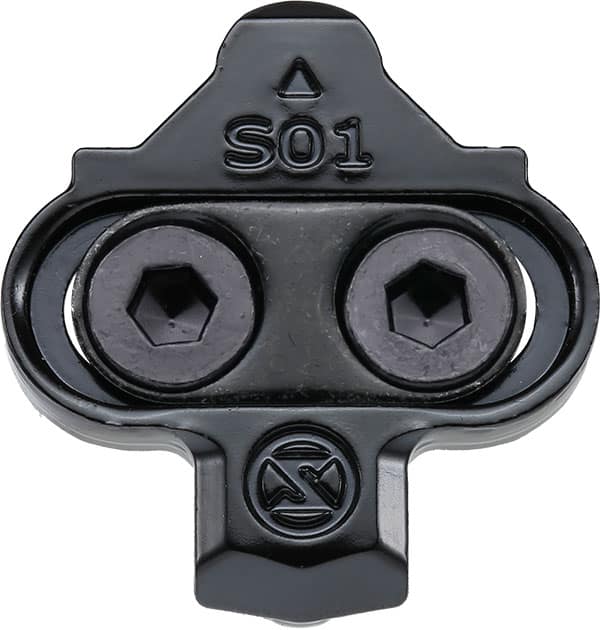
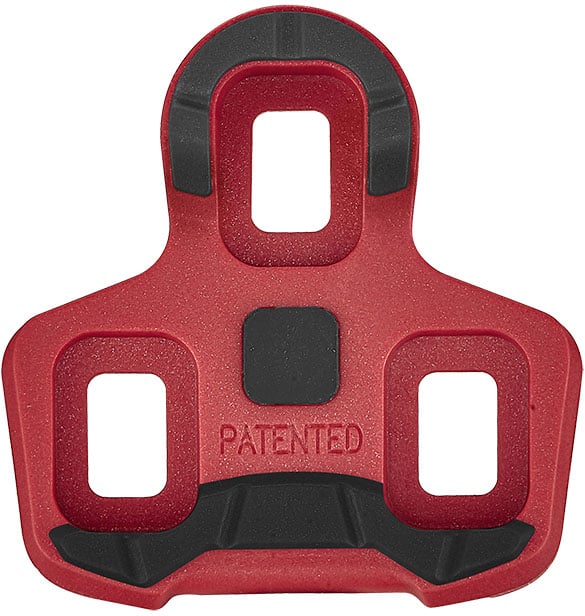
2 bolt cleats are mainly for mountain bikes.
The cleat is small and normally recessed into the cycling shoe.
Walking does not require the balancing act that you must perform with 3-bolt cleats. 2-bolts are also easier to get free of than 3-bolt models.
Mountain biking by definition means a greater likelihood of stopping and walking around—smelling the roses instead of barreling past them at MACH 1!
A 2-bolt cleat/cage system and associated shoe makes that easy.
Some road bike riders prefer the convenience of being able to walk around freely though.
They don’t need the particular benefits 3-bolt cleats deliver and so run some sort of 2-bolt system—keep that in mind as a possibility.
Now, your average MAMIL wouldn’t be seen with this setup.
Can you imagine a 2-bolt pedal/cleat adorning a prized Colnago or Pinarello? Nope, pretty unlikely.
3 Bolt Cleats
3 bolt cleats are for road bikes.
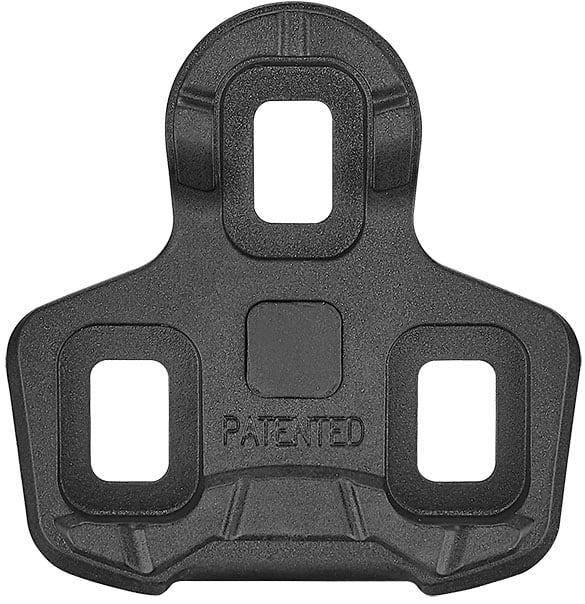
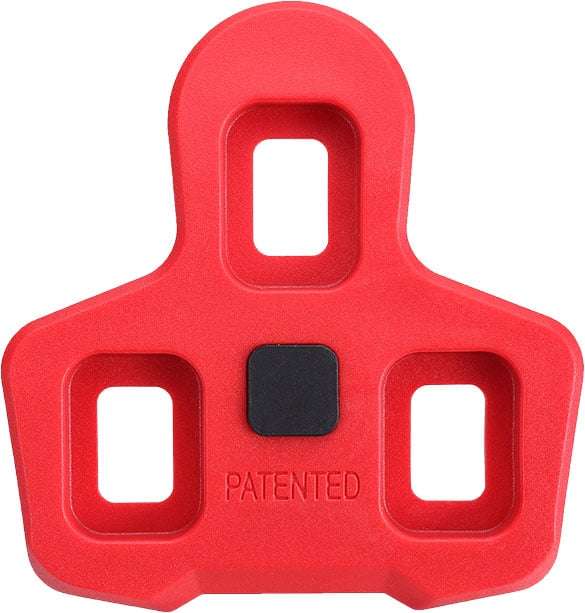
They are larger and thus cover a larger of shoe sole area.
This affords greater leverage and greater degree of stiffness, a quality which depends on sole stiffness of course.
The power transfer of a high-end shoe—Sidi’s carbon sole, for example—is noticeably higher than the cheaper alternatives.
Quite apart from the sole-stiffness variable, the energy transfer the increased leverage generates translates into an obvious increase in watts through the drive train.
How Do Clipless Pedals Work?
The cleat is shaped to fit into the pedal cage.
A 2-bolt pedal cage differs from a 3-bolt cage.
With 3-bolt cleats you slip the leading edge under the front of the pedal.
The cleat’s rear section rests on the pedal’s spring-loaded rear recess.
You press down.
“Click”.
The spring-loaded rear-recessed bracket forming is pressed back, then snaps back into position over the cleat’s rear top flanges.
Your foot is securely held—not locked mind you—in the pedal.
The mechanism also spans the whole pedal from the front to the back and left to right.
The degree of pressure needed to “click” in can be adjusted on most models.
If you prefer your clipless pedal firmly hold your foot to the pedal, then slightly turning a (usually 2mm) bolt increases the grip. Turn towards the + sign.
Alternately you can opt for minimum grip in which clipping in and out is much easier. Turn the bolt to the left or – sign.
Over time, cleats wear out. As the cleat loosens with wear, you turn the bolt to tighten the spring.
There is no definite technical advantage or disadvantage to this.
It’s largely psychological—we all have particular settings and adjustments that just feel comfortable or “right”.
2-bolt cleats have a similar structure to 3-bolt cleats with one variation.
In some designs, the downward pressure of the cleat forces a pair of spring loaded jaws apart.
The jaws open together and snap back into position together once the cleat touches the pedal base.
The pedal’s base—total surface area—also extends beyond the cleat mechanism itself. The cleat is much smaller, forming a small square in the center.
Clipping in and Clipping Out
A very important skill to master when using clipless pedals.
Strangely enough, there is more danger the slower you go.
Moving fast distributes the impact zone between your body and the road/ground.
When you go slow to the point of barely moving, the impact energy has nowhere to go—it remains localized at the impact point.
That point is most likely to be a bone; that bone is most likely to be a hip or femur. The chance of a compound fracture is quite high.
Don’t underestimate the force generated from what is effectively a fall from 1-1.5 meters in height.
You’ll never have to deal with that force, though, if you practice turning your shoe sideways all in one smooth movement.
The movement is generally outwards, away from the bike. For 2-bolt “pop-up” models pulling up releases the cleat.
Decide which shoe will be the “anchor” foot—the shoe which clips in first while the other maintains balance on the ground.
The technique implies a rule that the shoe you clip in second must be the one you clip out first when you need to stop.
It is by no means absolute though.
There will be times, usually in urgent or emergency situations, when the anchor shoe comes out first, or both must come out together and go to ground.
Still, making the clip-in clip-out sequence second nature based on a consistent anchor foot is a good habit to cultivate.
What is the Difference Between Clipless and SPD?
SPD stands for Shimano Pedalling Dynamics a type of 2-bolt clipless pedal released in 1990.
Shimano being a dominant brand, the term SPD has turned into another word for clipless bike pedal.
Just keep in mind that SPD is one type of clipless pedal, one that has stood the test of time.
Having considered bike pedals from the technical and functional viewpoint, let’s now have a look at each mode of biking in greater depth.
Your basic choice is: Do I use a flat or clipless pedal?
Flat pedals will be fine if you have an entry-level road bike.
There is really no need to go for the increased efficiency—but extra complications—of clipless pedals.
You will achieve your basic fitness and recreation goals on a basic bike with this type of pedal.
If you are looking for a higher level of performance, then a clipless model is the go.
What are the Best SPD Pedals for a Road Bike?—SPD vs SPD-SL
Remember that SPD Pedals are Shimano’s branded pedal design: there are quite a few others in particular Look’s Delta or KEO system.
The best SPD pedal is the one that is most suited to the type of riding you are into.
In this case you’ll probably be looking at a roadbike-specific SPD-SL model.
SPD—a 2-bolt cleat system—is for mountain bikes.
Nothing rules out using SPD for a road bike, of course, if that fits with the type of lifestyle riding you intend to do: taking it easy, frequent dismounts, walking around and so forth.
The SPD-SL advantage
You’ll need an SPD-SL pedal for enhanced performance.
Better performance comes from SPD-SL’s significantly wider platform.
For riders graduating from the narrower profile pedals to the wider platform a few years ago, the difference was notable.
The wider surface area affords greater leverage. Coupled with an upgrade to a shoe with a high-performance carbon sole, the feeling’s great.
For more info check out road.cc’s guide.
Cleats—Floating vs Fixed
The connection between your pedal and shoe is enabled by the cleat.
A cleat is pedal-specific. But for each type of cleat there is between zero degree of movement—the fixed cleat—or several degrees of movement—the floating cleat.
Technically, a floating cleat is not as efficient as a fixed cleat.
Energy from your pedal stroke is diverted from directly flowing into the drive train since your shoe pivots in the pedal. More for some, less for others depending on your technique.
A fixed cleat holds your shoe in position. All energy from the pedal stroke channels directly into the drive train without loss.
One disadvantage of a fixed cleat is potential knee strain during the pedal stroke. A floating cleat allows sideways movement and thus knee flex.
So if you have dodgy knees or perhaps a past injury, then cleats with float are probably the right choice for you.
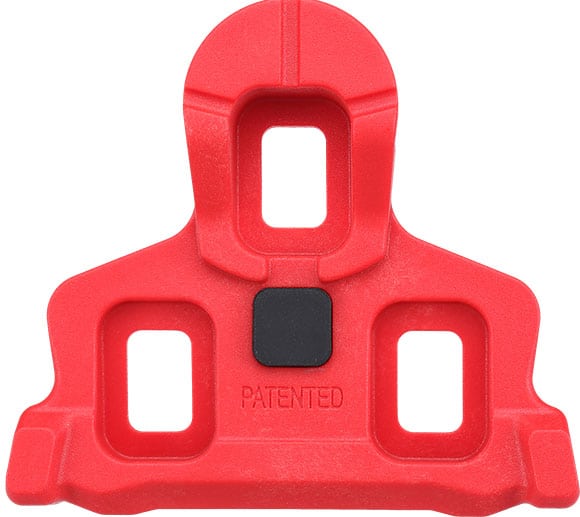
This SPD-SL-compatible cleat allows 6° of movement.
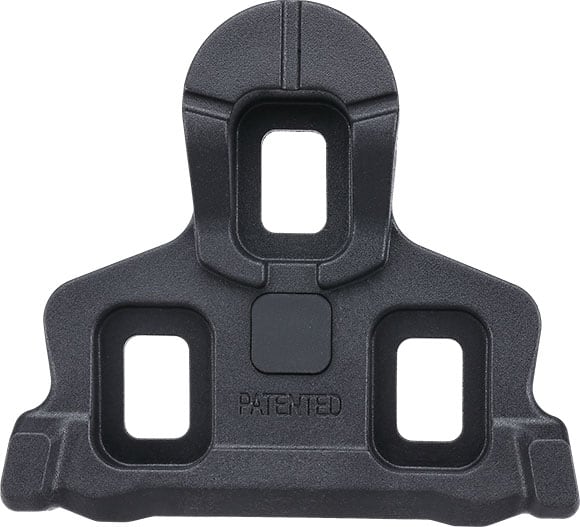
This SPD-SL-compatible cleat does not look any different from the one above.
However, with no movement allowed, it allows a more efficient energy transfer between your pistons (legs) and the bike’s rear wheel.
Look’s Delta and Keo System

This Delta-compatible cleat allows 9° of movement.
So if degrees of freedom are your thing, and you are not fussed over higher efficiency and performance, then this might be for you.
If have an existing Delta pedal, fixed cleats are on the market.
Again, the design appears to be no different. But small alterations in the cleat’s mould determines zero degree of movement.
You’ve got two functional choices: Flat (Platform) or Clipless.
At SCADA we’ve been integral to designing some baaaadass models for a number of brands … keep reading for examples.
Within the clipless category—2 bolt designs by the way—you go for double-sided or single sided. We’ll discuss why you would go for one or the other shortly.
Within each category you have more finely tuned variation. Which begs the question:
What are the Best Mountain Bike Pedals?
That entirely depends on what kind of riding you have in mind.
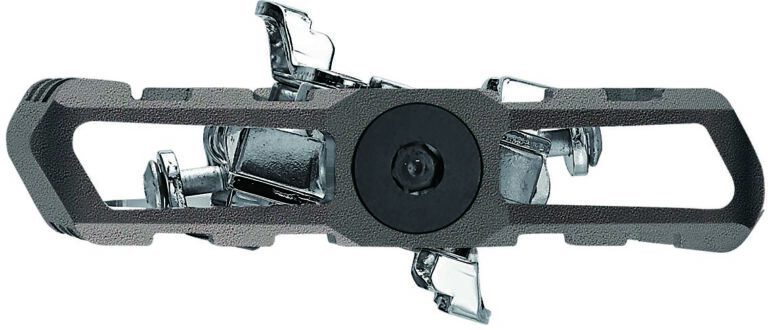
For example this model offers great stability along with an adjustable tilt angle.
The more experienced and advanced an MTB rider you are, the more particular your needs.
Or rather, the more you understand what components, and what particular spec will get you to your destination—literally and metaphorically.
There are many small brands out there producing awesome pedal designs for particular groups of riders.
Sixpack Racing’s Millenial pedal delivering a light-weight/high-durability/high-grip platform, for example, must rank up there with the very best.
When you know your needs (technically, skill-wise, or race-wise), then “best” becomes even more relative.
These days advanced engineering design principles coupled with ultra-sophisticated manufacturing technologies—SCADA’s forte by the way—are available.
Any rider can now express their personal style and individuality to a degree not possible in the past.
Should I Use Clipless Pedals on a Mountain Bike?
If you’re a seasoned rider then flats are probably your thing since the benefits are many.
If you are just starting out mountain biking, many experts would advise you to give clipless pedals a miss. Proceed directly to flats.
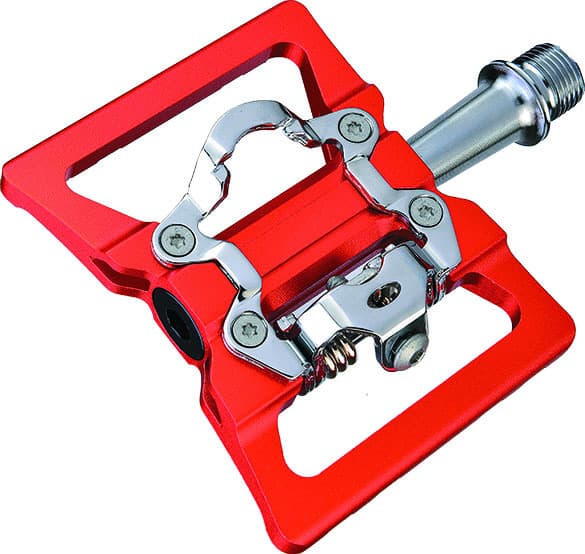
You’ll be a better rider and develop sound foundational skills that you probably won’t get with clipless pedals.
Learning to use your whole body to dyamically lift and shift your bike’s position in flight is a crucial skill. You’ll be able to hop logs rather than sticks.
Single Sided Pedal vs Double Sided
Double sided means you don’t have to pay so much heed to position your shoe correctly, making these more convenient.
A single sided pedal demands more attention on the click-in. You usually have to rotate the pedal to access the cage.
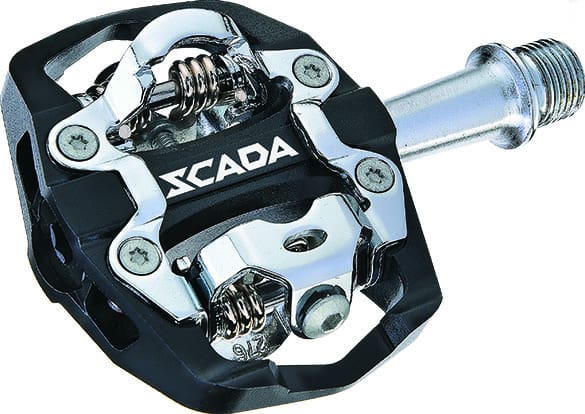
An advantage to a single-sided model though, is there will be times when you don’t want to click in. Going through an area with many traffic lights for example where clipping in and out may be an annoyance.
Not an issue out on the trail of course …
Some mountain bikers prefer to go double sided or with flats, citing poor grip on the non-clip surface.
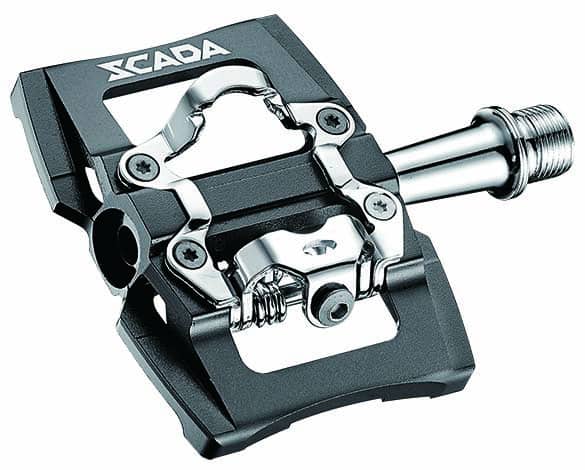
With a model like this, though, you’ve got pins for grip on the non-clip platform, along with a respectable surface area.
Like so much else in biking, personal preference determines the outcome.
There’s no definitive right or wrong.
However … having said that, the right flat pedal can enhance your trail experience no end!
What do you look for in a good BMX pedal?
It’s going to depend on whether you’re into freestyle or racing.
Variables to take into account include grip and weight.
For freestyle grip is probably more important with weight providing a slight edge in racing.
10 Pins
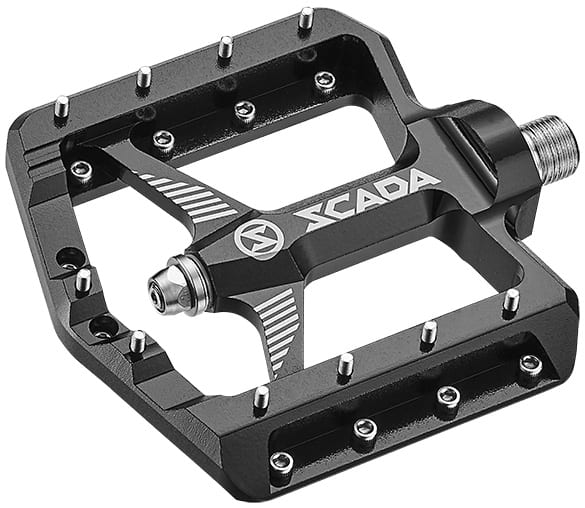
Cutting down on the weight, but skimping on the grip factor: 10 pins with this one.
Easily replace pins that are worn, bent, or broken.
A well-designed BMX pedal’s pedal pins should be easily removed and replaced.
Just keep a bunch of pins in a jar along with a 2mm allen wrench. You’ll be swapping out the ratty pins for good ones, and in various colors if that’s your thing.
Weight factors in when you need sustained bursts of speed by giving you a more efficient pedal-to-power ratio.
You’ll also find an oversized bearing. Together with the long chromoly axle, you’ve got yourself a pedal that’s going to last.
Magnesium
Magnesium is a lighter substitute for aluminum.
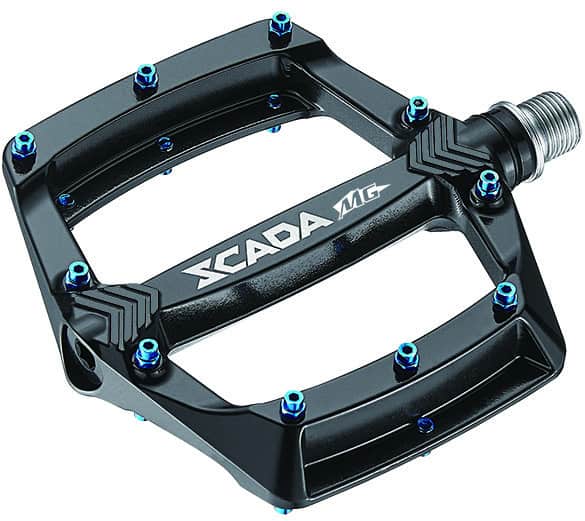
If weight savings are the focus of, say, your street freestyle routine, then a pair of magnesium pedals may be just the thing.
10 (replaceable) pins give you all the grip you practically need.
What’s the community verdict on magnesium pedals? Check out this interesting forum discussion.
Polycarbonate and Thermoplastic
Deceptively durable, these can take plenty of punishment over extended periods.
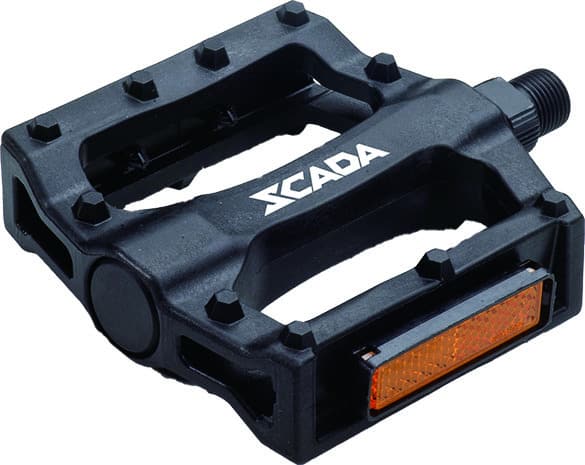
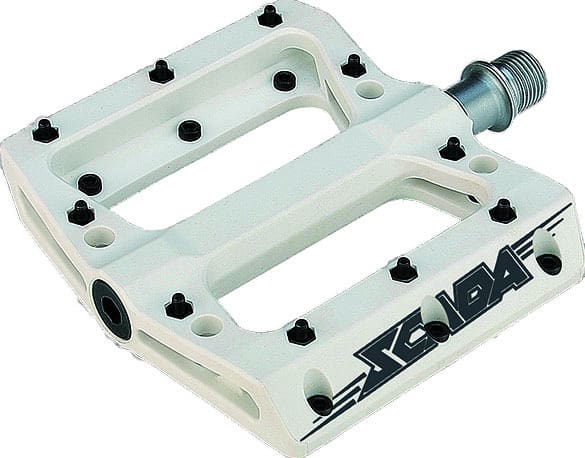
Chromoly axle CNC-ed to super-fine tolerances with replaceable pins.
Their durability is surprising.
Kids Pedals
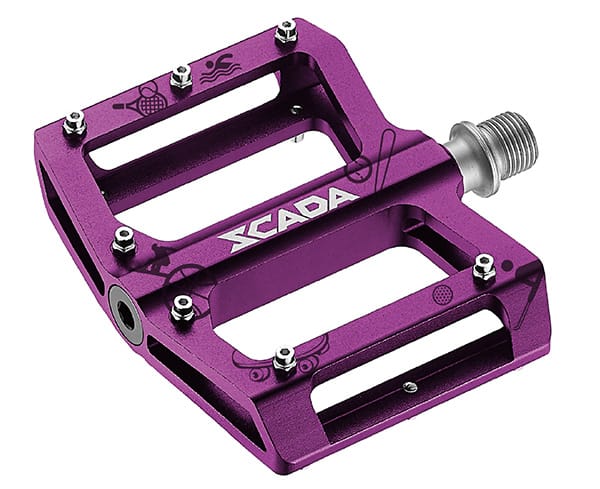
Appropriately sized for kids’ feet plus 6061 aluminium to further keep the weight down.
7 pins ensure their feet get a firm grip.
What characterizes a stylish yet functional city bike pedal?
Your customer, firstly, wants it to look good, to fit their bike’s vibe.
They also want dependable contact, durability, and visibility—they’ll be potentially often be riding at twilight or at night.
- A grippy surface, without the jagged roughness of your MTB or BMX pins
- An overall elegant look, at a glance, that doesn’t invite extra scrutiny..the “ewwww” factor
- Integrated reflectors that don’t look like they’re a glued-on after thought.
Clipless? Functional. But the look? Hmmm.
Anyway, the user won’t need the (incremental) energy efficiencies.Your customers certainly won’t be doing the annual tweed run on an SPD pedal or, heaven forbid, SPD-SL 🙄( not if you can help it … right?🤔😁).
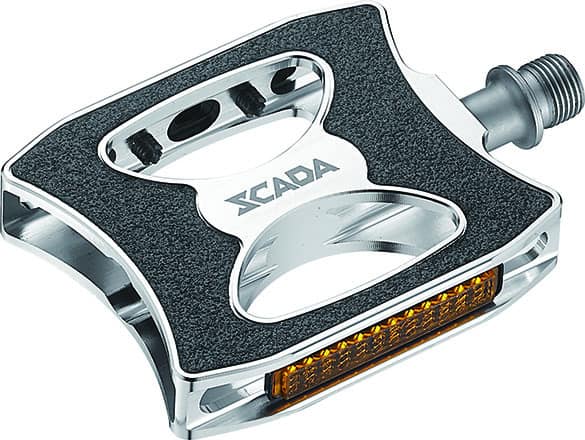
Tasteful curves. Recessed reflector. Grippy, very grippy, surface.
Light 6061 aluminum with a chromoly axle machined to the nth degree—this will last.
Sandpaper makes for a very grippy surface. Unlike pins there’s no chance at all of a chunk being taken out of those best boots or shoes.
Platform pedals are an option. However, the pins … nobody’s looking for pin-shaped marks, or worse, decorating their shins.
But if your customer is chalking up significant kilometers across the urban streetscape, a narrower profile is better.
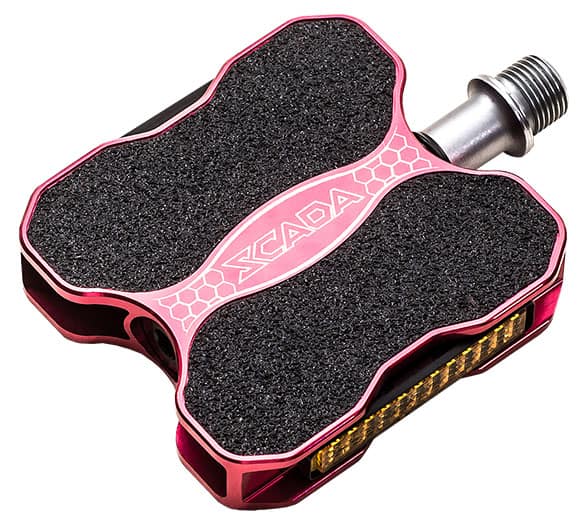
Pink for ladies … a bit clichéd. But talk to us about color options with this one.
Toe clips are a possibility—and that leads us to Indoor, or Spinning, Bike Pedals.
There are 2 categories of user to cater for:
- serious fitness user: into racing or sports cycling, marathon events, or triathlon
- aerobic fitness user
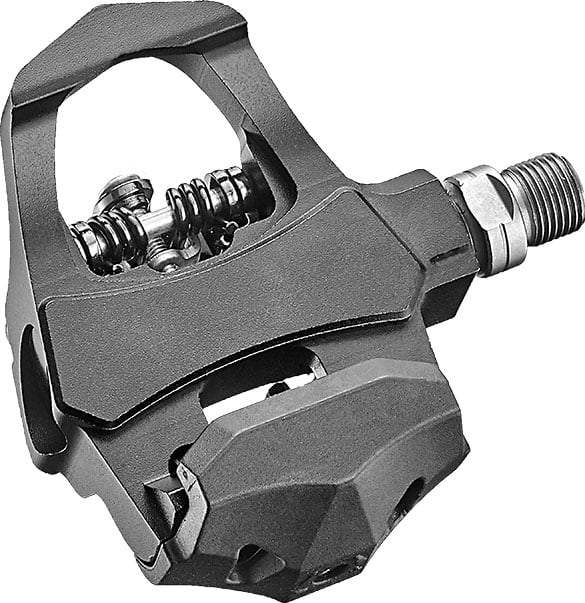
The serious fitness user is overly catered for with this.
Both 2-bolt and 3-bolt versions are available—on the single unit.
The hard-core cyclist or triathlon can prepare their shoes with the SC-DCR91 3-bolt cleat. The spinning experience will closely resemble their on-bike experience.
Toning it down, the SC-S01 cleat allows an “SPD” 2-bolt setup.
Flipping the pedal over reveals the press-in bracket ready to go.
Looks good on any indoor trainer to boot.d
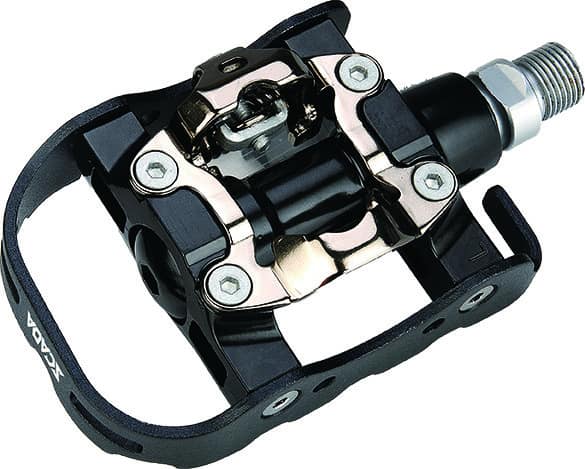
Aerobic fitness users can do with, or without, a cleat.
Clip in. Or, if there’s no cleat on the shoe, flip it over for a grippy, flat profile.
Toe Clip Pedals
These are also an option for city bikes.
The yesteryear charm can go well with the city bike look

This model sports a unique dual-function mode.
One side you have the adjustable toe clip which moves out and back in to conform to shoe/foot length.
The adjustable strap allows exact lateral fit, depending on the type of shoe, and foot size. Some people experience swelling (oedema) in one foot resulting in different sized feet.
You could also opt to remove the clip and use this pedal in conjunction with the 2-bolt cleat
That's a Wrap!
Congrats on getting through to the end of this book-length article 😅.
We sincerely hope you have found something useful somewhere in the many sections.
Any questions or comments?
The contact form is immediately below.
Get in touch today!
***
